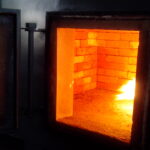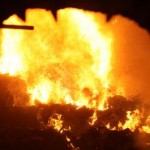Doubel Combustion Chamber
All Incinerators are Doubel Combustion Chamber with One Fuel Burner Each. After Burner Technology for Completely Combustion and Cleaner World.
Read MoreHigh Temperature Incineration
Temperature Range 800 Degree to 1200 Degree in Combustion Chamber. Temperature Thermocouple Monitor and Controller. High Quality Fire Brick and Refactory Cement.
Read MoreGet Lastest News
There are latest incinerator news like technical, public news, business tender for medical waste incinerator,animal incineration, pet cremation
Read MoreNanjing Clover Medical Technology Co.,Ltd.
Email: sales@clover-incinerator.com | Tel: +86-25-8461 0201
Regular model incinerator for market with burning rate from 10kgs to 500kgs per hour and we always proposal customer send us their require details, like waste material, local site fuel and power supply, incinerator operation time, etc, so we can proposal right model or custom made with different structure or dimensions.
Incinerator Model YD-100 is a middle scale incineration machine for many different usage: for a middle hospital sickbed below 500 units, for all small or big size family pets (like Alaskan Malamute Dog), for community Municipal Solid Waste Incineration, etc. The primary combustion chamber volume is 1200Liters (1.2m3) and use diesel oil or natural gas fuel burner original from Italy.
Latest Post
Smart Ash Incinerators
Smart Ash Incinerators
1. Size requirement for the incinerators is that the unit works with a 55 gallon open ended
steel drum.
2. The unit should operate wit. no fuel and use only 120V or 220V electricity for the blowers.
3. The unit should be capable of burning oil contaminated wastes and medical wastes with a moisture content of 0-15%J
4. Each unit should come witH two steel drums, so that a spare drum is available.
Spare Parts Option
If there are any vendor suggested spare parts , that list and price should be included as an option in the offer.
INDUSTRIAL INCINERATORS
Large incinerators – INDUSTRIAL INCINERATORS – specs below.
2.) Size requirement for the incinerators is 750 — 850 kg capacity
3.) The bum rate should be 80 LL 100 kg/ hour.
4) The primary chamber shouId have an operating temperature of 900 -1200 degree C.
5) The incinerator should hate a high temperature secondary chamber and 2 second gas
retention time at 850- 1150 degree C so that it is suitable for high risk materials.
6). The incinerator should have temperature monitoring and thermostat control for ease of
operation and assurance of bum temperature to confirm correct operation.
7). The incinerator should be capable of burning any of the hazardous wastes listed in the
subsequent section.
8) The incinerator should be capable of burning diesel oil and should include a larger fuel
tank (10-500 litres) and generator (3 –40 kV) set that can be carried on the trailer with the
incinerator so that the unit requires no external electrical power supply.
9.) The incinerator should be trailer mounted so that it is a po
Hazardous Waste to be Incinerated
Hazardous solid chemical:
Different types of combustible solids, used textiles, grease, and toner cartridges, chemicals
for water purification and photographic consumables and plastic material, empty
plastic/metal cans that still contain remnant hazardous material, oil absorbent.
Hazardous liquid chemical:
Mainly different types. of Acid, Paint, Varnish, Acetone, White Spirit Aromatic-less
Solvents, Synthetic Liquid for Break Systems, Aircraft De-icing Liquid, Hydraulic and
Compressor oil, Freon, used in some older refrigeration units, Insecticide liquid/spray, air
refresh spray and other similar chemicals.
Contaminated fuel:
Mainly diesel or gasoline contaminated by water or solvents.
Used and/or Contaminated oil:
Used motor oils and/or mineral oils unfit for their originally intended use. Mainly motor
and gearbox oil (approximately 80%) contaminated by a mixture of white spirit and acetone (approximately 51%), hydraulic liquid (approximately 5%).
Contaminated water:
Waste oilshvater, leaches, hydrocarbons/water mixtures, emulsions and leachate.
Contaminated soil:
Soil polluted by oil, fuel or 11 chemicals.
Contaminated soil polluted by chemicals that has to be recycled in landfill.
Contaminated soil—treated and replaced on site.
Oil Contaminated Solids
Rags, Absorbents, Cardboard, oil and fuel filters, air filters are not consider as hazardous materials.
Electronic waste:
Waste electrical or electronic appliances or assemblies, including printed circuit boards,
containing toxic material and/or heavy metal and/or emitting low radiation.
Used battery cells:
Dry battery, UPS battery or other types, unsorted waste batteries/ battery cells, containing
materials that are hazardouy.
Used lead-acid batteries:
Waste lead-acid batteries, rained/un-drained, and whole or crushed.
Hazardous medical waste:
Clinical and related waste, arising from medical, nursing or similar practices and waste
generated in clinics during the investigation or treatment of patients (bio hazard).
Expired drugs, solid:
Waste pharmaceuticals, drugs and medicines, including sensitive medicines.
Expired drugs Iiquid:
Waste liquid pharmaceuticals, different type liquid chemicals for treatment, medical
grease, and paraffin based xpired medicines.
Expired and/or contaminated fod:
Spoiled fresh food or unusable MRE’s (Meal Ready for Eat – dry food)
Onsite Training and Assem Option for Industrial Incinerators
I. The bidders should includ 1a price in their offer for training in a central location ( Goma or
Bukavu) approximately 15 staff in the operation and maintenance of the
equipment.
Incinerator Introduction
Principle of the Incinerator equipment is incineration/combustion/burn. Generally, the function is waste treatment for Solid waste, Liquid waste, Gas waste, etc.
The main body is one combustion chamber (at least), Refractory line or firebrick, Insulation materials and the outer plate. Ignition element is external oil or gas burner. The burner can be running until waste burnout but for some waste like plastic, paper (sometime, mix coal with waste before feeding), they can combustion itself after Ignition. During combustion, burner has a fan itself for Oxygen supply and also protect burner avoid heat damage from combustion chamber. And, there a external fan blow air into combustion chamber. The Exhaust gas blow out after combustion.
Considering Environmental Protection requirements and rules, almost all incinerator have secondary combustion chamber (after-burn, post-combustion), even if third combustion chamber. The secondary burner burn the Exhaust gas from primary combustion chamber, this technology make sure sufficient combustion, few black smoke and smell.
The updated incinerator technology focus on Exhaust gas treatment to remove Hazardous material and other function from incinerator, like heat recovery (waste to energy), save fuel cost, PLC Automation operation.
In some Developed countries, some new waste treatment method like High-temperature cooking, waste carbonization, crushing sterilization technology is instead of incineration technology.
incinerators plants
In the process of developing a project, we came across an issue, which is the estimate cost of incinerators plants (capable to destroy chlorinated in an environmental friendly way – please provide cost estimate/price range of incinerator plant).
- What kind of waste is to be burned?
- In which country the incinerators have to be installed?
- What about the amount of waste to be burnt per hour/day/week or per cycle?
- Ozone depleting Substances (chlorinated gas, CFC-11/12, HCFC-22 and similar mixtures), POPs (Polychlorierte Biphenyle mainly). Temperature of over 1200C is required.
- 150 MT of POPs (PCB) 210 MT of ODS for 3 countries in 2 years. Therefore it would be good to know the connection between price and capacity. (starting from 1 t/day for X USD till 10.000 t/day for XXXXUSD)
SHARP MEDICAL WASTES
A SET OF INCINERATOR FOR DISPOSAL OF SUCH HOSPITAL SHARP WASTES LIKE THE NEEDLES,SYRINGES,CUTTERS, BLADES, ETC.
WASTE BUCKET/TANK – ABOUT 2000KG
CAPACITY OF FEEDING: ABOUT 600-800Kg AT A TIME.
BURNING AT ABOUT 150/165-200 IN 60MINS
THE BURNER SHALL USE DIESEL/OIL
WITH CHIMNEY, ELECTRIC PANNELS,ELECTRIC MOTORS,ETC.
MATERIALS FOR DISPOSAL: SHARP MEDICAL WASTES.












